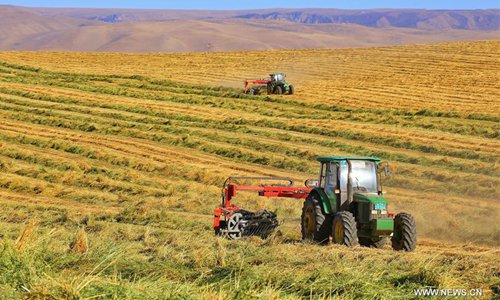China's resilient hay market benefits
US export; Australian trader eager to follow suit
Domestic hay traders diversify sources as demand rises

Farmers of a horse farm harvest wild oat grass in Shandan County of Zhangye City, northwest China's Gansu Province, Oct. 29, 2018. (Xinhua/Wang Chao)
Chinese hay traders have moved to diversify domestic and foreign suppliers, including from the US, as demand rises to a new high in China, the major consuming country for the livestock feed, industry insiders said.
International traders and producers expect a possible pick-up for buying Australian hay, amid rising expectations for improved bilateral relations following more interactions between the officials.
Industry sources said on Wednesday that the sector is experiencing a boom in demand and prices, driven by a rebound in consumption of meat and dairy products in China.
Regarding oat grass, about 70-80 percent of its consumption is home-grown, Wang Huoyong, a general manager with a large Beijing-based hay trading and producing company, told the Global Times.
In recent years, stimulated by rising market demand, the quality of domestic forage has improved. Many places in China offer suitable conditions for growing oat grass and alfalfa grass, the two major types of grass that are used for livestock feed.
Domestic grass planting is mainly distributed in Northwest China's Gansu and Ningxia, and North China's Inner Mongolia and Hebei Province.
The domestic output of high-quality oat grass in China can now meet most of market demand, Li Hongyu, with Tianjin Haoniu Bio-Tech Co, a Tianjin-based trader for hay and hay-related goods, told the Global Times on Wednesday.
In the first half of this year, the domestic alfalfa hay area of Grade 1 and above reached a historic 56.5 percent, and the proportion of Grade 2 and above reached 98 percent, according to media reports.
For example, Gansu Province can produce the same high-sugar B-type oat grass as from imported sources, and other areas such as North China's Chifeng can produce a large amount of A-type oat grass, Li said.
The great expansion of the domestic grass industry came as China's hay sector coped with the halt of Australian hay imports last year.
More than 20 Australian hay exporters have failed to get their import permits renewed since the end of February 2021.
While home-grown grass business is taking the lead, US grass is also benefiting. Several traders told the Global Times that they are importing large amounts of alfalfa grass from the US, with the volume growing every year.
From January to June, the import volume of alfalfa hay in China reached total of 741,900 tons, a year-on-year increase of 16.7 percent, maintaining a doubt-digit growth despite inflation.
The US is the major source of China's imports, with 593,400 tons imported from the country, accounting for 80.0 percent of the total. The US has been a good alternative to Australian oats in terms of quality and price, an insider said.
But with the elevated price driven by inflation, US alfalfa grass has lost ground to domestic producers. The US price has risen about 65 percent year-on-year so far this year.
Imports of US hay will fall by 15-20 percent to 1 million tons, Li predicted.
There are three Australian oat grass producers that export to China, accounting for all oat imports, but their prices are relatively high, Li said. Australian oat grass merchants are anxious to expand exports to China, which is an important export destination, Li added.



